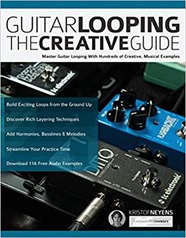 For completeness I include my review of Guitar Looping: The Creative Guide by Kristof Neyens. This is in the same series as Guitar Pedals by Rob Thorpe. These are both quite short books but I’ve found them useful.
For completeness I include my review of Guitar Looping: The Creative Guide by Kristof Neyens. This is in the same series as Guitar Pedals by Rob Thorpe. These are both quite short books but I’ve found them useful.
A looper pedal is a simple recording device which is started and stopped using a footswitch. A loop can be built up by making successive recordings, or layers, one on top of another. Typically loops are only a few bars long at most but modern looper pedals can record for tens of minutes.
I bought a looper pedal a year or so ago (reviewed here) and, to be honest, it has languished a bit on my pedalboard. I think the problem is a lack of education in the right format. Also I probably should have started with the simplest looper available, the author uses a tc electronic ditto rather than a step up (my Boss RC-3).
In common with Guitar Pedals, Guitar Looping contains lots (117) of short examples annotated in normal musical notation and guitar tab notation with accompanying audio files downloadable from the website. There is a brief text introduction to each example. I find these nice exercises in ear training, it’s good to be able to follow along with the tune.
The author is quite fond of the volume swell as part of a loop, this has got me thinking I need a volume pedal – previously I couldn’t see the point of them. This presents a problem because I’ve run out of space on my pedalboard!
Aside from the technical skill of starting and stopping loops at the appropriate point, there is also the skill of controlling the volume of your play within a layer and also getting the volume of different layers right. The loops illustrated often contain a percussive layer made by playing with strings muted, a rhythm/bass layer and a melodic layer which may be single notes or simple chords. Neyens talks about providing both harmonic space and dynamic space in layers. That’s to say there is no point in recording a layer loud and filled with sound because there is nowhere to put additional layers. This means that individual layers can sound quite simple and sparse. To get harmonic space you might play low notes with an octave pedal, on the lower three strings and melodies on the higher three strings, further up the neck.
The other useful piece of information I picked up was how to make your guitar sound like a clarinet! You pick the string 12 frets from where you are fretting – so if you are holding down the low E string on the third fret you need to pluck it and see. Try it and see.
After reading this book I’m using my looper pedal a bit more, there’s a lot of ideas in here and perhaps the most important thing is a stimulus to play around a bit – it doesn’t cost anything!

